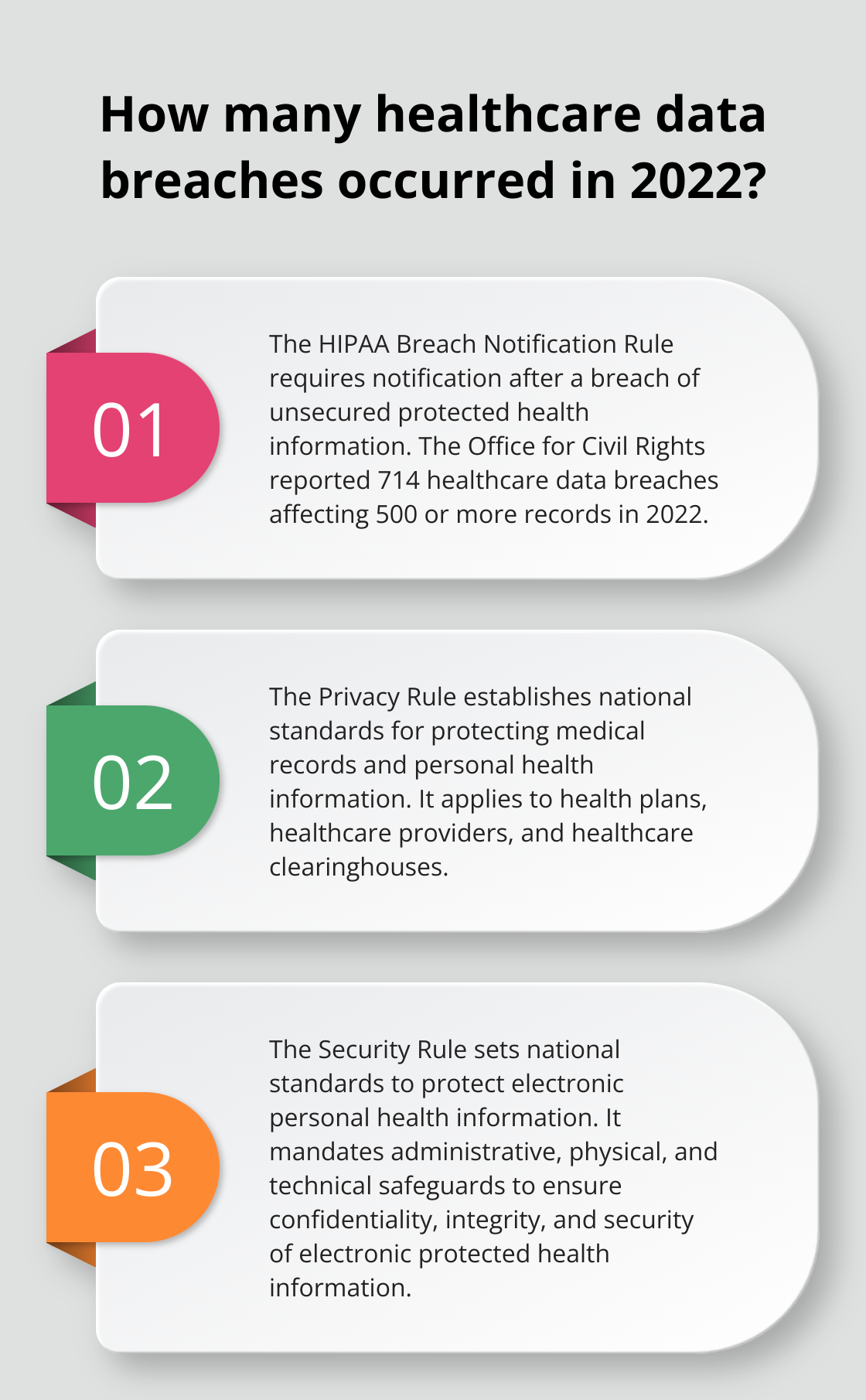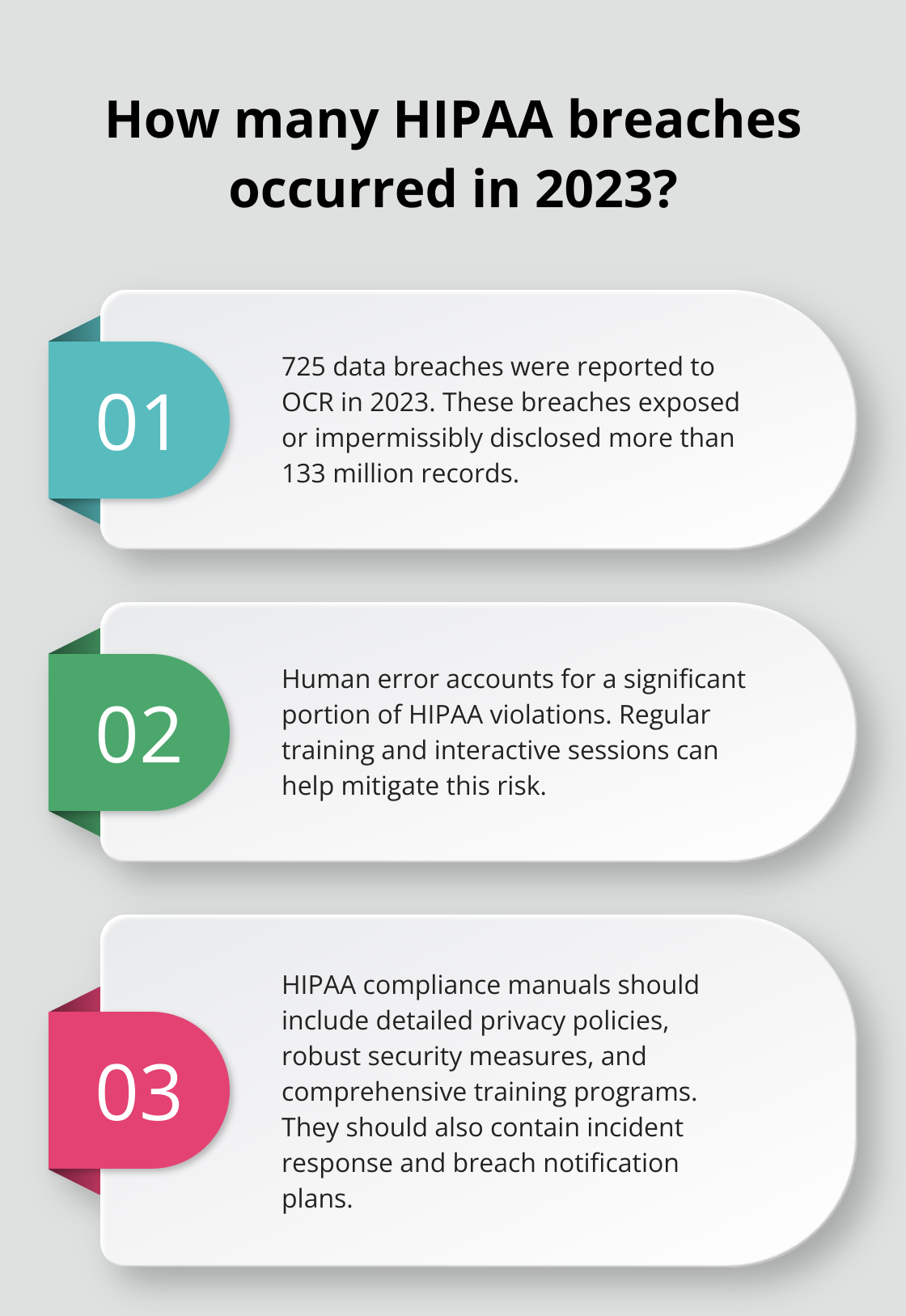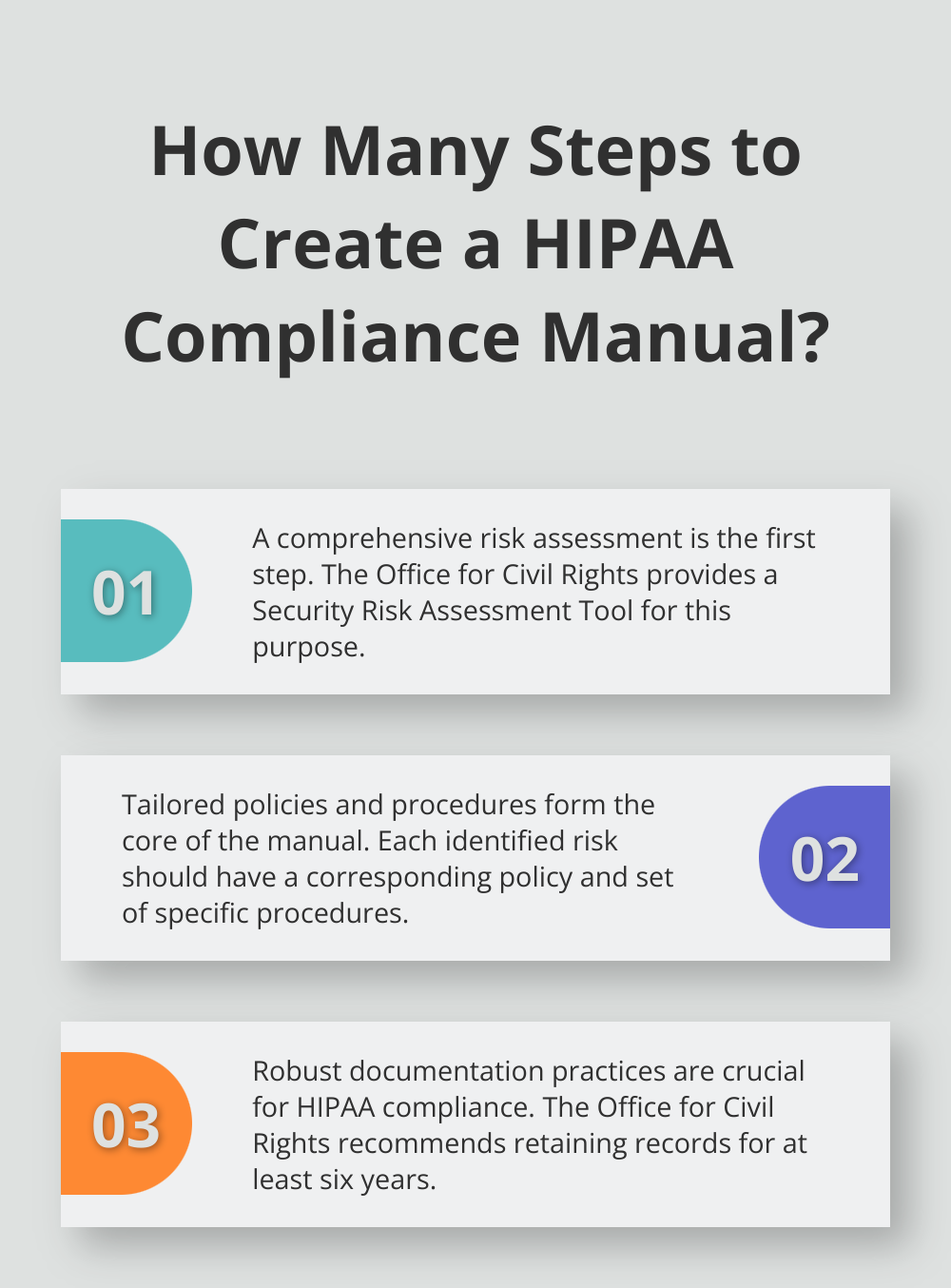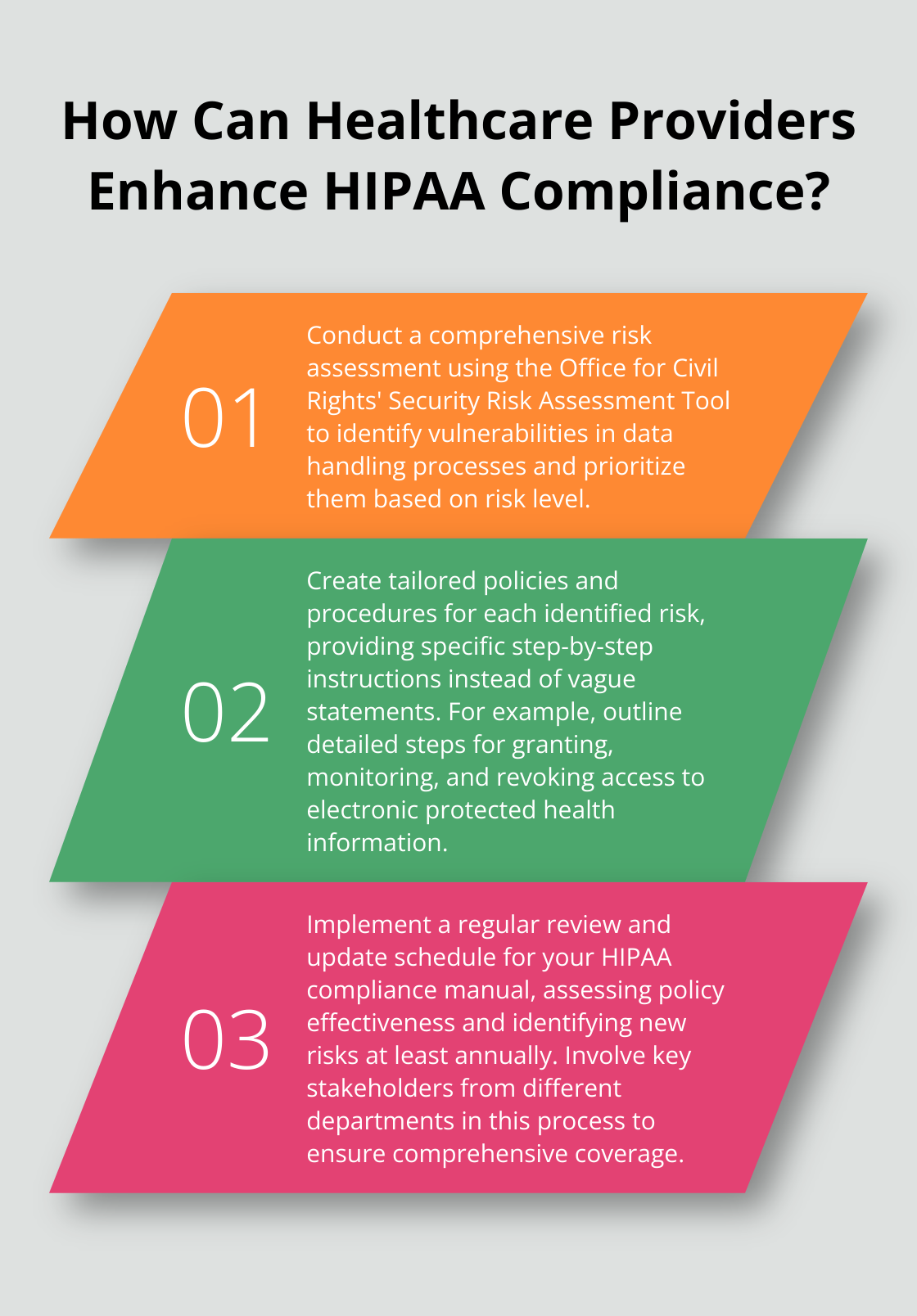Creating a HIPAA compliance manual is a critical step for healthcare organizations to protect patient data and avoid costly penalties. At ScriberJoy, we understand the complexities of HIPAA regulations and their impact on healthcare providers.
This guide will walk you through the essential components of a comprehensive HIPAA compliance manual and provide practical steps for its development and implementation. By following these guidelines, you’ll be well-equipped to establish a robust compliance program that safeguards patient information and maintains regulatory adherence.
Key HIPAA Rules: The Foundation of Patient Data Protection
The Privacy Rule: Protecting Patient Information
The HIPAA Privacy Rule establishes national standards for the protection of individuals’ medical records and other personal health information. It requires healthcare organizations to implement appropriate safeguards to protect patient privacy and sets limits on the uses and disclosures of such information without patient authorization.

The Privacy Rule provides individuals with a legal, enforceable right to see and receive copies upon request of the information in their medical and other health records maintained by their health care providers and health plans. This rule applies to health plans, healthcare providers, and healthcare clearinghouses.
The Security Rule: Safeguarding Electronic Health Information
The HIPAA Security Rule sets national standards to protect electronic personal health information created, received, used, or maintained by covered entities. It mandates appropriate administrative, physical, and technical safeguards to ensure the confidentiality, integrity, and security of electronic protected health information.
Recent data from HIPAA Journal highlights the ongoing challenges in data security, with reports of various breaches affecting healthcare organizations. This underscores the critical importance of robust security measures. To comply with the Security Rule, organizations must implement access controls, encryption for data (both in transit and at rest), and conduct regular security risk assessments.
The Breach Notification Rule: Addressing Data Breaches
The HIPAA Breach Notification Rule requires covered entities and their business associates to provide notification following a breach of unsecured protected health information. A breach is defined as an impermissible use or disclosure that compromises the security or privacy of the protected health information.
Under this rule, covered entities must notify affected individuals, the Secretary of Health and Human Services, and in some cases, the media, of a breach. The Office for Civil Rights reported 714 healthcare data breaches affecting 500 or more records in 2022, highlighting the need for a well-defined breach response plan.
Implementing HIPAA Rules: A Comprehensive Approach
The implementation of these rules requires a comprehensive approach to data protection. Healthcare organizations should consider using specialized tools designed with HIPAA compliance in mind. Such tools can significantly reduce the risk of data breaches and ensure that patient information remains secure throughout the documentation process.
For instance, ScriberJoy, a medical transcription software, combines AI with human verification to provide over 99% accurate medical documentation while maintaining HIPAA compliance. This type of solution can help healthcare providers streamline their documentation processes without compromising on data security.
As we move forward, it’s essential to understand how these key HIPAA rules translate into practical components of a HIPAA compliance manual. The next section will explore the essential elements that every healthcare organization should include in their compliance documentation.
What Should a HIPAA Compliance Manual Include?
A comprehensive HIPAA compliance manual serves as the cornerstone of any healthcare organization’s data protection strategy. It provides a roadmap for maintaining patient privacy, securing health information, and responding to potential breaches. This chapter explores the key components that every HIPAA compliance manual should include.
Detailed Privacy Policies and Procedures
Your manual must start with clear, actionable privacy policies. These policies should outline how your organization handles protected health information (PHI) in all its forms. Include specific procedures for:
- Obtaining patient consent for information sharing
- Responding to patient requests for access to their records
- Maintaining and updating Notices of Privacy Practices

To address the issue of maintaining up-to-date privacy policies, set a regular review schedule (ideally quarterly) to ensure your policies remain current with evolving HIPAA regulations.
Robust Security Measures
Security measures play a critical role in protecting electronic PHI (ePHI). Your manual should detail:
- Access control protocols, including unique user IDs and strong password requirements
- Encryption standards for data at rest and in transit
- Physical safeguards for devices containing ePHI
Combat unauthorized access issues by implementing role-based access controls and regularly auditing user privileges.
Comprehensive Training Programs
Employee training is vital for HIPAA compliance. Your manual should include:
- Initial HIPAA training protocols for new hires
- Annual refresher courses for all staff
- Specialized training for employees handling sensitive data
The Office for Civil Rights reports that human error accounts for a significant portion of HIPAA violations. Mitigate this risk by implementing interactive training sessions and quizzes to ensure staff retention of HIPAA principles.
Incident Response and Breach Notification Plans
A well-defined incident response plan is essential. Your manual should outline:
- Steps for identifying and containing potential breaches
- Procedures for notifying affected individuals and authorities
- Documentation requirements for breach investigations
According to a recent report, 725 data breaches were reported to OCR in 2023, exposing or impermissibly disclosing more than 133 million records. Try to reduce breach impact by conducting regular breach simulation exercises and updating your response plan accordingly.
Incorporating these elements into your HIPAA compliance manual will significantly enhance your organization’s ability to protect patient data and maintain regulatory compliance. A well-structured manual is not just a document-it’s a living guide that should evolve with your organization and the changing landscape of healthcare data protection.
Now that we’ve covered the essential components of a HIPAA compliance manual, let’s explore the practical steps to develop and implement this vital document in your healthcare organization.
How to Build Your HIPAA Compliance Manual
Conduct a Comprehensive Risk Assessment
Start your HIPAA compliance manual creation with a thorough risk assessment of your organization’s current practices. This step identifies potential vulnerabilities in your data handling processes. Use the Office for Civil Rights’ Security Risk Assessment Tool to systematically evaluate your current security measures.

Focus on areas where patient data is collected, stored, or transmitted during the assessment. Identify gaps in your current security protocols and prioritize them based on the level of risk they pose. This assessment will serve as the foundation for your compliance manual, guiding the development of policies and procedures.
Create Tailored Policies and Procedures
After completing your risk assessment, create policies and procedures that address the specific needs of your organization. Avoid generic templates – your manual should reflect your unique operational structure and risk profile.
Develop a corresponding policy and set of procedures for each identified risk. For example, if your assessment reveals vulnerabilities in access control, create a detailed policy outlining how access to electronic protected health information (ePHI) is granted, monitored, and revoked.
Provide specific instructions in your procedures. Instead of a vague statement like “Ensure proper access control,” include step-by-step instructions:
- IT department creates unique user IDs for each employee.
- Access levels are assigned based on job roles.
- Managers approve access requests.
- IT conducts quarterly access audits.
Establish Robust Documentation Practices
Proper documentation plays a critical role in HIPAA compliance. A good rule of thumb is to document in writing everything that relates to PHI. Plus, it should clearly highlight your past, current, and future environment. The Office for Civil Rights recommends retaining these records for at least six years.
Consider using a dedicated compliance management software to streamline this process. These tools can help you track policy versions, manage training records, and generate reports for audits. If budget constraints are a concern, even a well-organized spreadsheet can serve as a starting point for smaller practices.
Document your risk assessment findings, policy creation process, and any decisions made regarding HIPAA compliance. This documentation not only helps in maintaining compliance but also demonstrates your organization’s commitment to protecting patient information in case of an audit.
Implement Regular Review and Update Schedules
HIPAA compliance is an ongoing process that requires regular attention and updates. Establish a schedule for reviewing and updating your compliance manual. Try to review your policies and procedures at least annually (or more frequently if significant changes occur in your organization or in HIPAA regulations).
During these reviews, assess the effectiveness of your current policies, identify any new risks or vulnerabilities, and update your manual accordingly. Involve key stakeholders from different departments in this process to ensure comprehensive coverage of all aspects of your organization’s operations.
Utilize Compliance-Focused Tools
Leverage technology to enhance your HIPAA compliance efforts. Many software solutions are designed with HIPAA compliance in mind. These tools can significantly reduce the risk of data breaches and ensure that patient information remains secure throughout various processes.
When selecting tools for your organization, prioritize those that offer robust security features, access controls, and audit trails. Evaluate each tool’s compliance with HIPAA standards before integration into your workflows.
Final Thoughts
A HIPAA compliance manual serves as a comprehensive guide for healthcare organizations to protect patient privacy and maintain regulatory adherence. Healthcare providers must create tailored policies, implement robust security measures, and establish effective training programs to safeguard sensitive information. Regular reviews and updates of the manual ensure its effectiveness in the ever-changing landscape of healthcare data protection.

Organizations should conduct thorough risk assessments and develop specific procedures to address identified vulnerabilities. Proper documentation practices (including retention of records for at least six years) demonstrate commitment to protecting patient information during audits. Leveraging compliance-focused tools can significantly enhance an organization’s ability to secure patient data and streamline workflows.
Healthcare providers seeking to improve their documentation processes while maintaining HIPAA compliance can benefit from solutions like ScriberJoy’s medical transcription software. This tool combines AI technology with human verification to provide accurate medical documentation. By integrating such tools, healthcare organizations can enhance their compliance efforts and improve efficiency in patient care.

Leave a Reply
You must be logged in to post a comment.